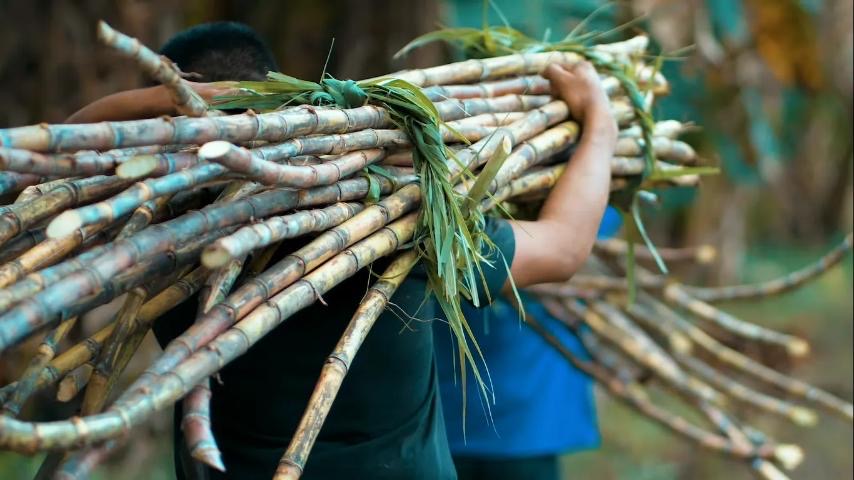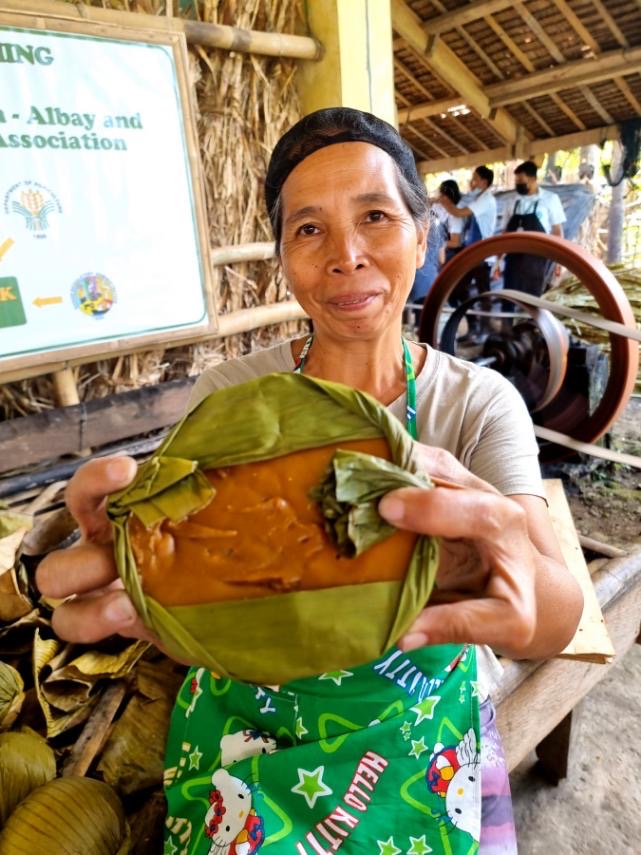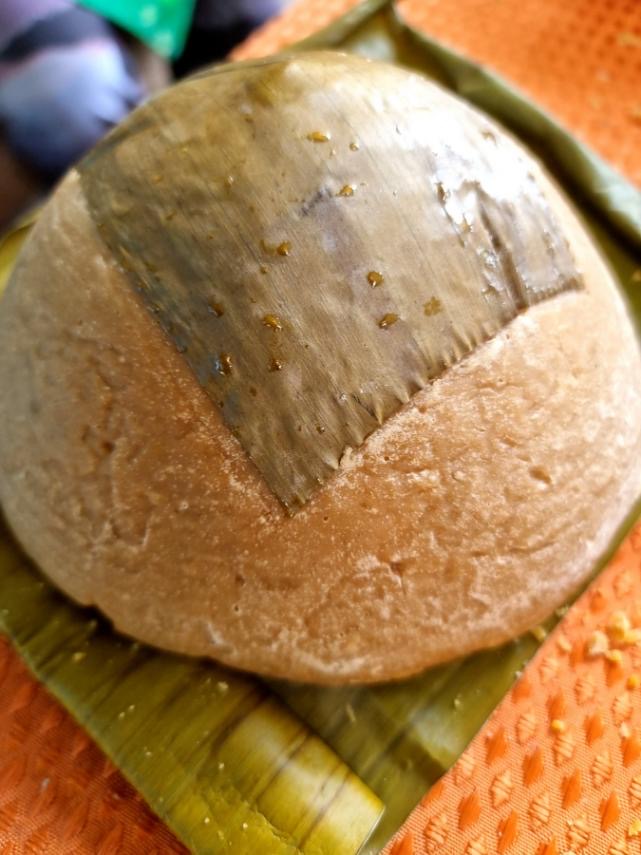The clanking sound of the engine reverberates the facility as Agnes Salcedo starts to take out the pieces of crushed sugarcanes his husband milled in the machine. Squeezing every ounce of juice, the once sturdy cane quickly turned into a thin piece of wood.
“Put the smaller canes first!” Jay Wilson Sandagon, the treasurer of the facility, shouts in the middle of the machine’s loud clanking.
Agnes’ husband immediately oblige, grabbing the smaller and shorter canes first.
Each sugarcane produces a sweet and sticky juice that flows directly out of the machine’s tube. In every five minutes, 25 to 30 pieces of sugarcane were crushed, filling an eighteen liter pail.
As Agnes’ husband began to transfer the pail of juice into an enormous pan most people called, kawa, their co-worker started to collect the residue of the extracted sugarcane, (which they now call bagasse) to be use as a combustible twigs in producing a fire.
About one meter beneath, Agnes’ husband crouched inside the facility’s makeshift furnace as he starts to fire the kawa with pieces of bagasse while patiently blowing the fire with his mouth until a cloud of smoke wafts out from the hole of the furnace.
As the fire starts to reach the desire level of heat, Agnes’ husband moved out of the furnace and drink a glass of water she prepared.
In about 30 minutes, my nose began to catch that strong and sweet aroma of boiling sugarcane juice. Just by then, I know it will make a good kind of sangkaka.
Agnes and her husband were just few hard working farmers of the Gamot Luya Dalugo (GALUDA) Farmer’s Association in Polangui, Albay.
Located in Gamot, Polangui Albay, this small community of farmers fosters the spirit of solidarity with their modernized practice of growing sugarcane and making products out of the plant material.
Sustaining the industry
Polangui has long been known for producing kalamay or sangkaka and GALUDA Farmer’s Association is one of the organizations that sustains and keeps that industry alive.
In an interview with Bicol.PH, Bob Ranzon, the president of GALUDA Farmer’s Association, said that the farm was founded in 2018 through the help of the Department of Trade and Industry (DTI) and Department of Agrarian and Reform (DAR).
DAR donated two hectares of nurseries to the association which they plants with sugarcane, corn, and peanuts, while DTI help build and improve their facility.
Ranzon also assures the best quality of products from the farm as they also maintain good and modernized farming practices which were taught during their training at the Naga College Foundation in 2018.
“Para maiwasan ang labis na pinsala ng bagyo, tinatanim namin yung tubo ng pahiga,” Ranzon told Bicol.PH. “Kusang tutubo yung halaman sa mata nung tubo at puputulin na lang namin kapag harvest time na. After 45 days, tutubo ulit yung halaman kasi the body remains planted under the soil.”
[To avoid excessive damage from the typhoon, we plant the sugarcane horizontally. The plant will grow spontaneously at the eyes of the sugarcane and we will just cut it when it’s harvest time. After 45 days, the plant will grow again because the body remains planted under the soil.]
This way of cultivation is referred as ratooning which is a practice of producing a second crop from the plant’s original body. Growing and harvesting sugarcane in this manner also prolongs the life span of the sugarcane for two years, making it more sustainable and practical.
All founding farmers and members of GALUDA Association were trained in various agricultural fields such as farming history, land preparation, and good farming management.
Two types of Sangkaka
GALUDA’s sugarcane also produces two varieties of sangkaka or sweetener in a compact form, namely angkun and lagting.
Angkun has a distinct snail-like texture and pale in color, produced out of sugarcane that makes white sugar. It is also the first class sangkaka commonly used for making biko and coco jam.
On the other hand, lagting is the second class sangkaka produced out of red sugar. It has a more refine texture and brownish color just perfect for making sinukmani.
“Nagkakaiba din ang dalawang ‘to dahil sa soil na gamit,” Sandagon said while holding angkun on his right hand and lagting on the left. “Pag sandy o buhaghag ang lupa, lagting. Kapag clay type, angkun.”
[These two also differs because of the soil used. When the soil is sandy or porous, it will make lagting. When its clay type, angkun.]
Apart from the soil type, weather conditions also affects the growth and product of a sugarcane. If it rains, the sugar content of a sugarcane also decreases.
Solidarity at its sweetest form
Producing sangkaka and other products out of a sugarcane also takes a lot of teamwork.
Sandagon said that their work at the facility starts as early as 6 in the morning and ends at 7 in the evening.
At around 6 a.m., farmers starts to harvest the sugarcane and carries it to the facility that is located about 500 meters away from the plantation.
As it reaches the plantation, they clean the sugarcane using a power washer then crush the sugarcane using the juice extractor machine. As they extract the juice from the cane, they transfer the juice into a kawa and boil it for two hours.
After two hours of boiling, the syrup has to be manually stirred to keep its viscosity and avoid from sticking into the kawa.
In about 5 to 10 minutes, the thickened syrup will be transferred to another kawa and mold immediately into a half-sphere shape using a coconut shell.
That’s usually the work of Agnes in the farm, where she and the other female farmers are responsible for packaging the sangkaka.
Using the coconut shell, Agnes will quickly and carefully scoops the sugarcane syrup and mold it into half sphere shape.
After 5 to 8 minutes of cooling, one by one, Agnes will flip the shell into a rectangular banana leaf, and after some twists and folds, you will have a fully packaged and finished GALUDA sangkaka product.
Story of sweet success
Just like the sangkaka that’s gone on a long process, Agnes has been making sangkaka for quite a long time now.
In fact, sugarcane farming and sangkaka production has been her family’s livelihood even before she was born.
She’s now 52 and a mother to six children; and even though life’s not been easy for them, their hard work thickened like the syrup of the sugarcane juice they produce as three of her children were able to finish college at Bicol University Polangui Campus.
Just like the fire in the makeshift furnace, Agnes’ and her husband’s burning desire bears another fruit as their third children attain latin honor, cum laude, under the degree of education.
“Mahirap ang hanapbuhay namin pero gusto kong maabot nila ang kanilang mga pangarap,” Agnes said as she fold the banana leaf of a last piece of sangkaka she’s packaging.
[Our job is difficult, but I want them to reach their dreams.]
Sustaining life under this industry is also not easy, but if you’re going to ask Agnes if she still wants her children to pursue the same work, there’s only one but sure answer that she knows.
“Hindi ko sila pipilitin pero sapat na sa akin na makitang may isa sa kanilang magpatuloy sa pagawa ng kalamay kasi ito ang bumuhay sa pamilya namin.”
[I will not force them, but it’s enough for me to see one of them continue this work because this is what brought life to our family.]
Agnes and her husband are residents of Gamot, Polangui and has been working with GALUDA since 2018. | Ken Oliver V. Balde




